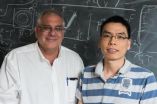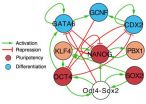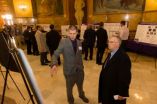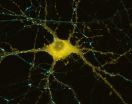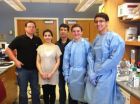(Press-News.org) HOUSTON – (June 16, 2014) – How does a stem cell decide what path to take? In a way, it's up to the wisdom of the crowd.
The DNA in a pluripotent stem cell is bombarded with waves of proteins whose ebb and flow nudge the cell toward becoming blood, bone, skin or organs. A new theory by scientists at Rice University shows the cell's journey is neither a simple step-by-step process nor all random.
Theoretical biologist Peter Wolynes and postdoctoral fellow Bin Zhang set out to create a mathematical tool to analyze large, realistic gene networks. As a bonus, their open-access study to be published this week by the Proceedings of the National Academy of Sciences helped them understand that the process by which stem cells differentiate is a many-body problem.
"Many-body" refers to physical systems that involve interactions between large numbers of particles. Scientists assume these many bodies conspire to have a function in every system, but the "problem" is figuring out just what that function is. In the new work, these bodies consist not only of the thousands of proteins expressed by embryonic stem cells but also DNA binding sites that lead to feedback loops and other "attractors" that prompt the cell to move from one steady state to the next until it reaches a final configuration.
To test their tool, the researchers looked at the roles of eight key proteins and how they rise and fall in number, bind and unbind to DNA and degrade during stem cell differentiation. Though the interactions may not always follow a precise path, their general pattern inevitably leads to the desired result for the same reason a strand of amino acids will inevitably fold into the proper protein: because the landscape dictates that it be so.
Wolynes called the new work a "stylized," simplified model meant to give a general but accurate overview of how cell networks function. It's based on a theory he formed in 2003 with Masaki Sasai of Nagoya University but now takes into account the fact that not one but many genes can be responsible for even a single decision in a cellular process.
"This is what Bin figured out, that one could generalize our 2003 model to be much more realistic about how several different proteins bind to DNA in order to turn it on or off," Wolynes said.
A rigorous theoretical approach to determine the transition pathways and rates between steady states was also important, Zhang said. "This is crucial for understanding the mechanism of how stem cell differentiation occurs," he said.
Wolynes said that because the stem cell is stochastic -- that is, its fate is not pre-determined -- "we had to ask why a gene doesn't constantly flip randomly from one state to another state. This paper for the first time describes how we can, for a pretty complicated circuit, figure out there are only certain periods during which the flipping can occur, following a well-defined transition pathway."
In previous models of gene networks, "Instead of focusing on proteins actually binding to DNA, they just say, 'Well, there's a certain high level of this protein or low level of that protein,'" Wolynes said. "At first, that sounds easier to study because you can measure how much protein you've got. But you don't always know if it is bound. It has become increasingly clear that the rate of protein binding to DNA plays an important role in gene expression, particularly in eukaryotic systems."
The notion that many-body effects even existed in cells began in 1942 when British scientist C.H. Waddington established the idea of an epigenetic landscape for stem cells as a way to describe why pluripotent cells in embryos are destined to turn into bone, muscle and all the other parts of the body – but don't turn back. Waddington compared the cells' paths to marbles rolling to the bottom of a valley.
That concept rang true to Wolynes. His energy landscape theory has become key to understanding protein folding, although that theory sees the landscape as a funnel rather than a valley. "Waddington said that as a cell develops into an embryo and beyond, it becomes many different kinds of cells," Wolynes said. "Those cells might branch off and differentiate further, but they don't typically go back to the original state and start over.
"His analogy – the idea of falling down through a valley – kicked around for a long time, but it was hard to make it mathematically precise. In his time, they didn't know about DNA," Wolynes said.
In both energy and epigenetic landscapes, Wolynes said, the steady state at the bottom is an attractor. "It means wherever you start from, you end up attracted to that same place," he said. "In genetic networks, things like steadily oscillating patterns can also be considered attractors."
Once biologists began to understand genetic switches in DNA, the whole picture became more complicated, he said. "The landscape now has to incorporate the active parts of DNA that are trying to decide whether to turn this gene on or that gene off. In the '50s, we learned how genes made decisions on the basis of their production of proteins. These proteins then act back on the same genes in a kind of feedback loop."
The loops allow genes to remain active for far longer than it would take a protein simply to bind or unbind to a section of DNA. In the researchers' equations, the loops become attractors that help regulate transformation of the cell and can be mapped onto the many-body landscape.
Analyzing the coupled dynamics of all these chemical reactions in a cell could be done by brute force, he said, but the computational cost would be enormous. So the Rice team decided to take a big-picture approach based on Wolynes' earlier work. It so happened that the resulting theoretical models of embryonic stem cells matched nicely with what experimentalists had seen in their studies.
For example, the models explained the fluctuations experimentalists had observed in the expression of a master regulator, a protein called nanog, and its important role in maintaining a cell's pluripotency. Stem cells move from one steady state to the next on their journeys; in their calculations, they found a much higher level of nanog gene expression in what they called SC1, the basic stem cell, than in SC2, a stem cell that had moved to the second steady state. This matched what experiments had measured, the researchers said.
"This is still just a beginning," Wolynes said. "We're looking at embryonic stem cells now, but someday we want to treat the complete developmental program of organisms with hundreds of genes. We can see how these mathematics can scale up to that regime."
INFORMATION:
Wolynes is the Bullard-Welch Foundation Professor of Science and a professor of chemistry and a senior scientist with the Center for Theoretical Biological Physics (CTBP) at Rice.
The D.R. Bullard-Welch Chair at Rice University and the National Science Foundation (NSF)-sponsored CTBP, supported the research. The researchers utilized the Data Analysis and Visualization Cyberinfrastructure supercomputer supported by the NSF and administered by Rice's Ken Kennedy Institute for Information Technology.
Read the open-access paper at XXXXXXXXX
This news release can be found online at http://news.rice.edu/2014/06/16/many-bodies-prompt-stem-cells-to-change/
Follow Rice News and Media Relations via Twitter @RiceUNews
Related Materials:
Wolynes Research Lab: http://wolynes.rice.edu/node/2?destination=node/2
Center for Theoretical Biological Physics: http://ctbp.rice.edu
BioScience Research Collaborative: http://brc.rice.edu/home/
Images for download:
http://news.rice.edu/wp-content/uploads/2014/06/0623_STEM-1-web.jpg
Peter Wolynes, left, and Bin Zhang of Rice University tested their new method to analyze large gene networks to begin to understand how stem cells differentiate. (Credit: Jeff Fitlow/Rice University)
http://news.rice.edu/wp-content/uploads/2014/06/0623_STEM-2-WEB.jpg
An overview of the stem cell gene network gives a sense of the complex process involved in cell differentiation, as transcription factors and protein complexes influence and loop back upon each other. Rice University researchers found that stem cell differentiation can be defined as a many-body problem as they developed a theoretical system to analyze large gene networks. (Credit: Bin Zhang/Rice University)
Many bodies prompt stem cells to change
Rice University scientists apply new theory to learn how and why cells differentiate
2014-06-16
ELSE PRESS RELEASES FROM THIS DATE:
Researchers create better methods to detect E. coli
2014-06-16
MANHATTAN, KANSAS — Kansas State University diagnosticians are helping the cattle industry save millions of dollars each year by developing earlier and accurate detection of E. coli.
Lance Noll, master's student in veterinary biomedical science, Greensburg; T.G. Nagaraja, university distinguished professor of diagnostic medicine and pathobiology; and Jianfa Bai, assistant professor in the Kansas State Veterinary Diagnostic Laboratory, are leading a project to improve techniques for detecting pathogenic Shiga toxin-producing E. coli O157:H7. A U.S. Department of Agriculture ...
Getting rid of old mitochondria
2014-06-16
It's broadly assumed that cells degrade and recycle their own old or damaged organelles, but researchers at University of California, San Diego School of Medicine, The Johns Hopkins University School of Medicine and Kennedy Krieger Institute have discovered that some neurons transfer unwanted mitochondria – the tiny power plants inside cells – to supporting glial cells called astrocytes for disposal.
The findings, published in the June 17 online Early Edition of PNAS, suggest some basic biology may need revising, but they also have potential implications for improving ...
Discovery of Earth's northernmost perennial spring
2014-06-16
Boulder, Colo., USA – A Canadian team lead by Stephen Grasby reports the discovery of the highest latitude perennial spring known in the world. This high-volume spring demonstrates that deep groundwater circulation through the cryosphere occurs, and can form gullies in a region of extreme low temperatures and with morphology remarkably similar to those on Mars. The 2009 discovery raises many new questions because it remains uncertain how such a high-volume spring can originate in a polar desert environment.
Grasby and colleagues encountered the northernmost perennial ...
Pathological gambling runs in families
2014-06-16
A study by University of Iowa researchers confirms that pathological gambling runs in families and shows that first-degree relatives of pathological gamblers are eight times more likely to develop this problem in their lifetime than relatives of people without pathological gambling.
"Our work clearly shows that pathological gambling runs in families at a rate higher than for many other behavioral and psychiatric disorders," says Donald W. Black, MD, professor of psychiatry in the UI Carver College of Medicine. "I think clinicians and health care providers should be alerted ...
Low dose of targeted drug might improve cancer-killing virus therapy
2014-06-16
COLUMBUS, Ohio – Giving low doses of a particular targeted agent with a cancer-killing virus might improve the effectiveness of the virus as a treatment for cancer, according to a study led by researchers at The Ohio State University Comprehensive Cancer Center – Arthur G. James Cancer Hospital and Richard J. Solove Research Institute (OSUCCC – James).
Viruses that are designed to kill cancer cells – oncolytic viruses – have shown promise in clinical trials for the treatment of brain cancer and other solid tumors. This cell and animal study suggests that combining low ...
How our brains store recent memories, cell by single cell
2014-06-16
Confirming what neurocomputational theorists have long suspected, researchers at the Dignity Health Barrow Neurological Institute in Phoenix, Ariz. and University of California, San Diego School of Medicine report that the human brain locks down episodic memories in the hippocampus, committing each recollection to a distinct, distributed fraction of individual cells.
The findings, published in the June 16 Early Edition of PNAS, further illuminate the neural basis of human memory and may, ultimately, shed light on new treatments for diseases and conditions that adversely ...
Omega (ω)-3 inhibits blood vessel growth in a model of age-related macular degeneration in vivo
2014-06-16
Boston (June 16, 2014) – Age-related macular degeneration (AMD), which is characterized by choroidal neovascularization (CNV), or blood vessel growth, is the primary cause of blindness in elderly individuals of industrialized countries. The prevalence of the disease is projected to increase 50% by the year 2020. There is an urgent need for new pharmacological interventions for the treatment and prevention of AMD.
Researchers from Massachusetts Eye and Ear/Schepens Eye Research Institute, Harvard Medical School and other institutions have demonstrated for the first time ...
Caterpillars that eat multiple plant species are more susceptible to hungry birds
2014-06-16
Irvine, Calif. — For caterpillars, having a well-rounded diet can be fraught with peril.
UC Irvine and Wesleyan University biologists have learned that caterpillars that feed on one or two plant species are better able to hide from predatory birds than caterpillars that consume a wide variety of plants.
This is probably because the color patterns and hiding behaviors of the caterpillar "specialists" have evolved to allow them to blend into the background flora more effectively than caterpillars that eat many different plant species. Moving among these diverse plant ...
Hunt for extraterrestrial life gets massive methane boost
2014-06-16
A powerful new model to detect life on planets outside of our solar system, more accurately than ever before, has been developed by UCL (University College London) researchers.
The new model focuses on methane, the simplest organic molecule, widely acknowledged to be a sign of potential life.
Researchers from UCL and the University of New South Wales have developed a new spectrum for 'hot' methane which can be used to detect the molecule at temperatures above that of Earth, up to 1,500K/1220°C – something which was not possible before.
To find out what remote planets ...
Physician anesthesiologists identify 5 tests and procedures to avoid
2014-06-16
Proving that less really is more, five specific tests or procedures commonly performed in anesthesiology that may not be necessary and, in some cases should be avoided, will be published online June 16 in JAMA Internal Medicine. The "Top-five" list was created by the American Society of Anesthesiologists® (ASA®) for inclusion in the ABIM Foundation's Choosing Wisely® campaign.
"The Top-five list of activities to question in anesthesiology was developed in an effort to reduce unnecessary, costly procedures and improve patient care," said Onyi Onuoha, M.D., M.P.H., lead ...
LAST 30 PRESS RELEASES:
Tracing the quick synthesis of an industrially important catalyst
New software sheds light on cancer’s hidden genetic networks
UT Health San Antonio awarded $3 million in CPRIT grants to bolster cancer research and prevention efforts in South Texas
Third symposium spotlights global challenge of new contaminants in China’s fight against pollution
From straw to soil harmony: International team reveals how biochar supercharges carbon-smart farming
Myeloma: How AI is redrawing the map of cancer care
Manhattan E. Charurat, Ph.D., MHS invested as the Homer and Martha Gudelsky Distinguished Professor in Medicine at the University of Maryland School of Medicine
Insilico Medicine’s Pharma.AI Q4 Winter Launch Recap: Revolutionizing drug discovery with cutting-edge AI innovations, accelerating the path to pharmaceutical superintelligence
Nanoplastics have diet-dependent impacts on digestive system health
Brain neuron death occurs throughout life and increases with age, a natural human protein drug may halt neuron death in Alzheimer’s disease
SPIE and CLP announce the recipients of the 2025 Advanced Photonics Young Innovator Award
Lessons from the Caldor Fire’s Christmas Valley ‘Miracle’
Ant societies rose by trading individual protection for collective power
Research reveals how ancient viral DNA shapes early embryonic development
A molecular gatekeeper that controls protein synthesis
New ‘cloaking device’ concept to shield sensitive tech from magnetic fields
Researchers show impact of mountain building and climate change on alpine biodiversity
Study models the transition from Neanderthals to modern humans in Europe
University of Phoenix College of Doctoral Studies releases white paper on AI-driven skilling to reduce burnout and restore worker autonomy
AIs fail at the game of visual “telephone”
The levers for a sustainable food system
Potential changes in US homelessness by ending federal support for housing first programs
Vulnerability of large language models to prompt injection when providing medical advice
Researchers develop new system for high-energy-density, long-life, multi-electron transfer bromine-based flow batteries
Ending federal support for housing first programs could increase U.S. homelessness by 5% in one year, new JAMA study finds
New research uncovers molecular ‘safety switch’ shielding cancers from immune attack
Bacteria resisting viral infection can still sink carbon to ocean floor
Younger biological age may increase depression risk in older women during COVID-19
Bharat Innovates 2026 National Basecamp Showcases India’s Most Promising Deep-Tech Ventures
Here’s what determines whether your income level rises or falls
[Press-News.org] Many bodies prompt stem cells to changeRice University scientists apply new theory to learn how and why cells differentiate
